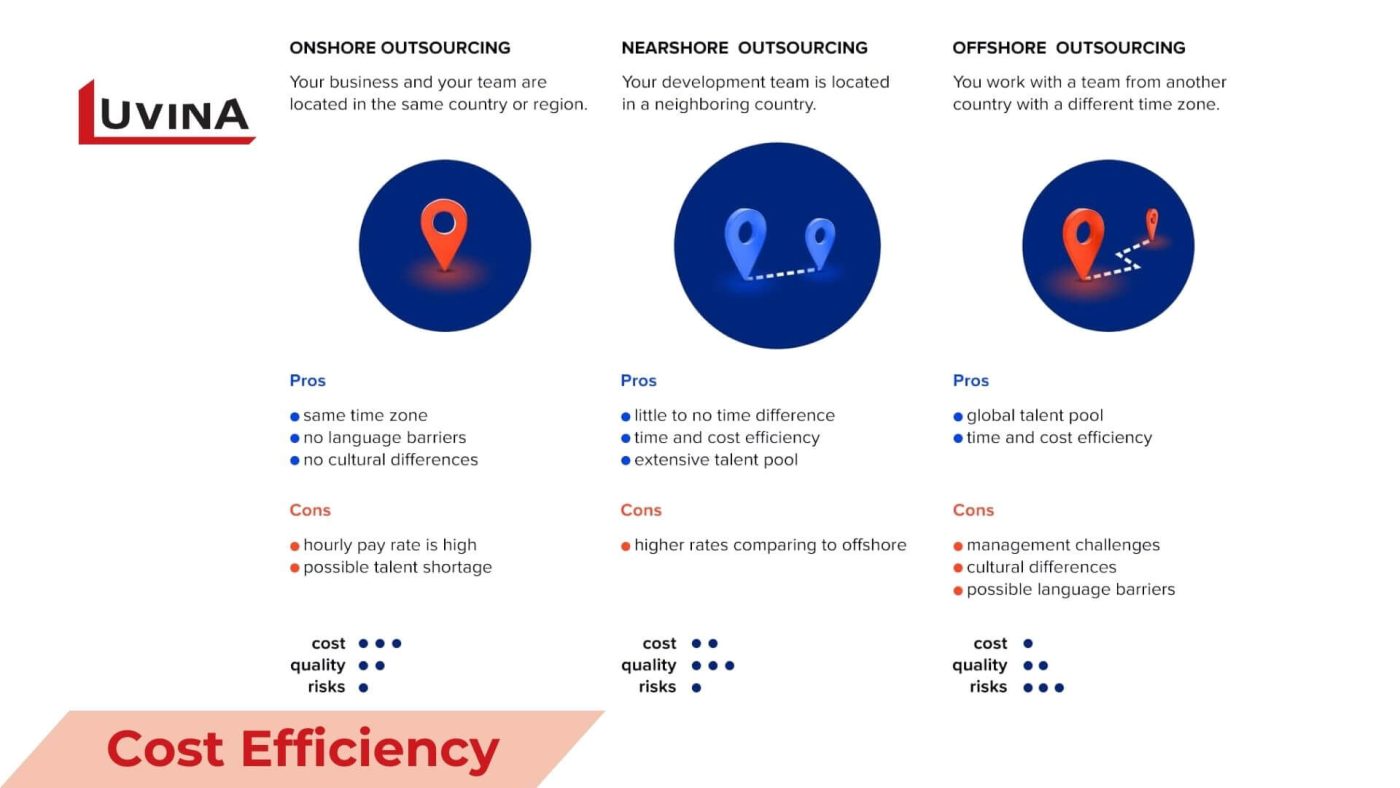In today’s technology-driven business landscape, deciding between nearshore and offshore software development models is a critical choice. It’s essential to understand the distinctions between these types of IT outsourcing and select the nearshore software development company that aligns best with your business’s specific needs.
Defining Offshore and Nearshore Software Development
To begin, it’s crucial to define nearshore and offshore software development and highlight what sets them apart.
Nearshore Software Development:
– Nearshore software development involves collaborating with software development teams in neighboring or nearby countries.
– This model leverages geographic proximity, shared time zones, and often, cultural affinity, making it an optimal choice for streamlined communication.
Advantages of Nearshore Software Development Company
Nearshore software development company offers several key advantages for businesses. These include:
– Proximity and Efficiency: Being close to your nearshore team means easy travel when needed and real-time collaboration, facilitating quick issue resolution.

– Cultural Affinity: Cultural alignment fosters smoother communication and a better understanding of business goals and expectations.
– Time Zone Synergy: Shared or similar time zones ensure real-time communication and reduce the risk of time zone-related delays.
– Ease of Communication: Geographic proximity allows for frequent in-person meetings, video conferences, and rapid email responses.
– Reduced Travel Costs: Travel costs related to on-site visits are typically lower when working with nearshore teams.
– Enhanced Collaboration: Close proximity supports a close working relationship, improving project efficiency and issue resolution.
– Quality of Service: Nearshore teams are renowned for delivering high-quality services due to the advantages of the nearshore model.
Offshore Software Development:
– Offshore software development involves partnering with development teams located in distant countries or regions.
– While offshore development offers access to a diverse global talent pool and potential cost savings, it’s typically characterized by significant time zone differences and potential language barriers.
Advantages of Offshore Development Service
Conversely, offshore software development offers a unique set of benefits:
– Global Talent Pool: Access to a diverse talent pool with a wide range of skills and expertise.
– Cost Efficiency: Lower labor costs in offshore locations result in cost-effective software development.

– Scalability: The ability to quickly scale up or down according to project requirements.
– 24/7 Development: Time zone differences allow for round-the-clock development, enabling continuous project advancement.
– Varied Expertise: Offshore teams bring a broader range of expertise, especially in specialized fields such as AI, blockchain, and data analytics.
– Diverse Solutions: The diversity of talent allows for a wide range of solutions and strategies tailored to your specific business needs.
>> See more: Offshore Software Development: A Comprehensive Guide
Choosing Nearshore Software Development Company
Selecting nearshore development is advantageous in various scenarios:
1. Real-Time Collaboration: If your project necessitates frequent real-time collaboration, the shared time zone in the nearshore model ensures effective communication and swift issue resolution.
2. Cultural Affinity: For businesses that prioritize shared cultural values and alignment, nearshore development can offer a significant advantage.
3. Quick Turnaround: Projects with tight deadlines benefit from proximity and efficient communication, as well as the ability to quickly address issues.
4. Oversight Ease: Maintaining tight oversight and control over your project, with the possibility of regular on-site visits and in-person meetings.
5. Emerging Markets: When exploring emerging markets while maintaining a reasonable level of geographic proximity, nearshore development in those regions is a strategic choice.
Choosing Offshore Development
Offshore development is advantageous in the following scenarios:
1. Cost Efficiency: When your primary focus is cost savings, and you’re willing to navigate the challenges of time zone differences and potential language barriers.
2. Global Talent Requirements: If your project requires diverse expertise, including rare or specialized skills, offshore development’s access to a vast talent pool is invaluable.
3. Large-Scale Projects: Offshore development is ideal for large-scale projects that require rapid scalability and 24/7 development capabilities.
4. Niche Technologies: When your project involves niche technologies or complex requirements, offshore teams with diverse expertise can address these challenges effectively.
Among the prominent nearshore software development companies, Luvina Software stands out as a leading provider of high-quality software solutions.
Luvina Software is strategically headquartered in Mexico, offering the advantages of geographic proximity and cultural alignment, making it an ideal nearshore partner for businesses seeking effective communication, collaboration, and cost-effective solutions.
Why Choose Luvina Software?
– Proximity and Cultural Affinity: Luvina Software’s Mexico-based location ensures geographic proximity and shared cultural values, providing the ideal nearshore partnership.
– Quality Services: With a proven track record of delivering high-quality software solutions, Luvina Software is committed to ensuring the success of your projects.
– Technological Expertise: Luvina Software’s team possesses expertise in a broad spectrum of technologies, ensuring that your specific requirements are met with precision.
– Effective Communication: The nearshore model embraced by Luvina Software fosters efficient communication and real-time collaboration.

– Cost-Effective Services: Luvina Software offers cost-effective nearshore solutions that balance quality and affordability.
Decision-Making Framework
When choosing between nearshore and offshore development models, it’s essential to establish a decision-making framework tailored to your business’s unique needs. Consider the following steps:
1. Project Requirements: Begin by clearly defining your project’s goals, timeline, budget, and specific needs.
2. Priorities: Determine your business’s top priorities, whether they are cost savings, real-time communication, or access to a particular skill set.
3. Cultural Alignment: Assess the importance of cultural affinity and shared values in your project.
4. Industry Considerations: Evaluate how your industry’s nature and regulatory requirements influence your choice.
5. Review Case Studies: Examine case studies and success stories
of businesses that have selected nearshore or offshore development models.
6. Expert Advice: Seek guidance from industry experts and individuals with experience in both models.
>> See more: Offshore vs. Onshore Software Development
Conclusion
In the ever-evolving software development landscape, the choice between nearshore and offshore models is a pivotal decision for businesses. While both models offer unique advantages, your choice should be guided by your project requirements, business priorities, and industry considerations.
Nearshore development, exemplified by companies like Luvina Software, provides the advantages of proximity, cultural affinity, and quality services. These qualities make it an attractive choice for businesses seeking effective communication, collaboration, and cost-effective solutions.
{ Get everything you ever
wanted to know about IT.}
Read More From Us?
Sign up for our newsletter








Read More From Us?
Sign up for our newsletter
Read More From Us?
Sign up for our newsletter